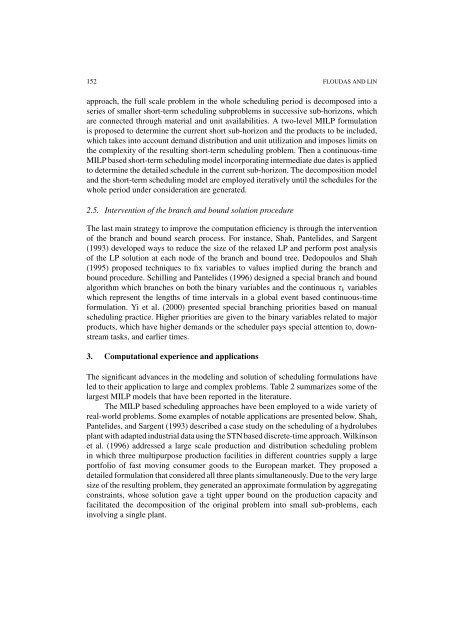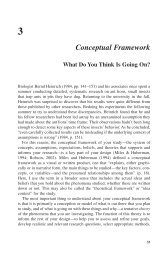Mixed Integer Linear Programming in Process Scheduling: Modeling ...
Mixed Integer Linear Programming in Process Scheduling: Modeling ...
Mixed Integer Linear Programming in Process Scheduling: Modeling ...
You also want an ePaper? Increase the reach of your titles
YUMPU automatically turns print PDFs into web optimized ePapers that Google loves.
152 FLOUDAS AND LIN<br />
approach, the full scale problem <strong>in</strong> the whole schedul<strong>in</strong>g period is decomposed <strong>in</strong>to a<br />
series of smaller short-term schedul<strong>in</strong>g subproblems <strong>in</strong> successive sub-horizons, which<br />
are connected through material and unit availabilities. A two-level MILP formulation<br />
is proposed to determ<strong>in</strong>e the current short sub-horizon and the products to be <strong>in</strong>cluded,<br />
which takes <strong>in</strong>to account demand distribution and unit utilization and imposes limits on<br />
the complexity of the result<strong>in</strong>g short-term schedul<strong>in</strong>g problem. Then a cont<strong>in</strong>uous-time<br />
MILP based short-term schedul<strong>in</strong>g model <strong>in</strong>corporat<strong>in</strong>g <strong>in</strong>termediate due dates is applied<br />
to determ<strong>in</strong>e the detailed schedule <strong>in</strong> the current sub-horizon. The decomposition model<br />
and the short-term schedul<strong>in</strong>g model are employed iteratively until the schedules for the<br />
whole period under consideration are generated.<br />
2.5. Intervention of the branch and bound solution procedure<br />
The last ma<strong>in</strong> strategy to improve the computation efficiency is through the <strong>in</strong>tervention<br />
of the branch and bound search process. For <strong>in</strong>stance, Shah, Pantelides, and Sargent<br />
(1993) developed ways to reduce the size of the relaxed LP and perform post analysis<br />
of the LP solution at each node of the branch and bound tree. Dedopoulos and Shah<br />
(1995) proposed techniques to fix variables to values implied dur<strong>in</strong>g the branch and<br />
bound procedure. Schill<strong>in</strong>g and Pantelides (1996) designed a special branch and bound<br />
algorithm which branches on both the b<strong>in</strong>ary variables and the cont<strong>in</strong>uous τk variables<br />
which represent the lengths of time <strong>in</strong>tervals <strong>in</strong> a global event based cont<strong>in</strong>uous-time<br />
formulation. Yi et al. (2000) presented special branch<strong>in</strong>g priorities based on manual<br />
schedul<strong>in</strong>g practice. Higher priorities are given to the b<strong>in</strong>ary variables related to major<br />
products, which have higher demands or the scheduler pays special attention to, downstream<br />
tasks, and earlier times.<br />
3. Computational experience and applications<br />
The significant advances <strong>in</strong> the model<strong>in</strong>g and solution of schedul<strong>in</strong>g formulations have<br />
led to their application to large and complex problems. Table 2 summarizes some of the<br />
largest MILP models that have been reported <strong>in</strong> the literature.<br />
The MILP based schedul<strong>in</strong>g approaches have been employed to a wide variety of<br />
real-world problems. Some examples of notable applications are presented below. Shah,<br />
Pantelides, and Sargent (1993) described a case study on the schedul<strong>in</strong>g of a hydrolubes<br />
plant with adapted <strong>in</strong>dustrial data us<strong>in</strong>g the STN based discrete-time approach. Wilk<strong>in</strong>son<br />
et al. (1996) addressed a large scale production and distribution schedul<strong>in</strong>g problem<br />
<strong>in</strong> which three multipurpose production facilities <strong>in</strong> different countries supply a large<br />
portfolio of fast mov<strong>in</strong>g consumer goods to the European market. They proposed a<br />
detailed formulation that considered all three plants simultaneously. Due to the very large<br />
size of the result<strong>in</strong>g problem, they generated an approximate formulation by aggregat<strong>in</strong>g<br />
constra<strong>in</strong>ts, whose solution gave a tight upper bound on the production capacity and<br />
facilitated the decomposition of the orig<strong>in</strong>al problem <strong>in</strong>to small sub-problems, each<br />
<strong>in</strong>volv<strong>in</strong>g a s<strong>in</strong>gle plant.
















